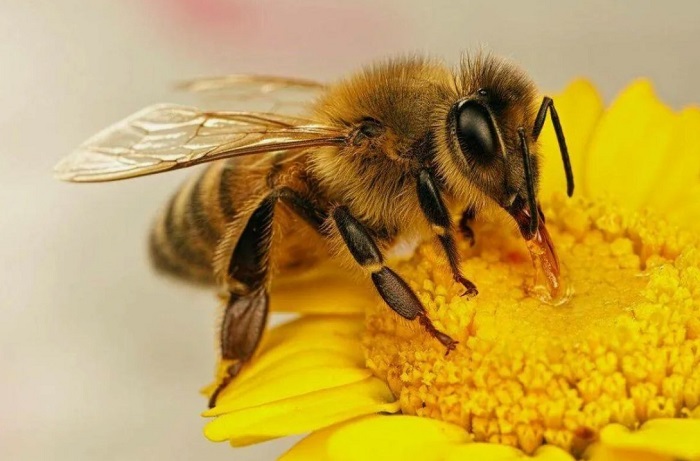nCa Report
Honeybees hardly ever get the attention they deserve. The World Bee Day (20 May) came and went without much fanfare in Central Asia.
The honeybee population has been under constant threat for a long time.
Dr Anneke Veenstra, the Senior Lecturer at the School of Life and Environmental Sciences, Deakin University (Australia), writes in an article that is available at the university website, “There’s been an extraordinary decline in honey bee colonies around the world in recent years, and the reasons for the drop remain largely unknown.”
“But why does this matter and how does it affect us?,” she asks rhetorically, and answers: “Honey bees are the world’s most prolific pollinators of food crops, with one third of the food we eat every day relying on pollination. This includes fruit, vegetables, oils and nuts. As far as important species go, honey bees are at the top of the list. ‘They’re essential pollinators – pollinating 70 of the around 100 crop species that feed 90% of the world.”
“Overseas, honey bees are declining at an alarming rate. One of the main reasons for the decline is the varroa mite (a parasite that attacks honey bees). In America before 1988 there were five million hived honey bee colonies. Then the varroa mite arrived, and by 1993 that number had diminished to 2.5 million. The other possible reasons for the decline include the loss of flower meadows, climate change, and the use of pesticides,” adds Dr Veenstra.
The picture she draws is alarming: “We could struggle to sustain the global human population. If we lost all the plants that honey bees pollinate, the small animals that eat those plants will be negatively impacted resulting in fewer prey species for larger carnivorous animals and so on up the food chain.
The amount of fresh produce available to us would also change significantly. Walking into a supermarket would be a different experience, you could expect to find half the amount of fruit and vegetables that are available today.”
A Bloomberg report by Lara Williams is titled: Bee-Eating Hornets Are Just the Start of the Alien Invasions.
Filed on 4 April 2024, the report warns that the Asian hornet, also known as the yellow-legged hornet, a native of Southeast Asia, was threatening the honeybee populations in the UK and Europe because of its voracious appetite for the honeybee. It is categorized as an invasive alien species.
In Europe and North American there are efforts to improve the resilience of the honeybee by genetic reinforcement and other methods. In some cases it has been observed that the honeybee is learning to fight back to protect itself.
There is also the drive to ban the pesticides and insecticides that threaten the honeybee.
As far as Central Asia is concerned, the website upl.uz has recently published a highly disturbing report.
We are producing here the report in full:
Scientists have stated that because of Uzbekistan, Central Russian bees will soon disappear
In the near future, Central Russian bees will disappear. This was stated by scientists from the Ufa Federal Research Center of the Russian Academy of Sciences (RAN).
According to experts, bees from Central Asia are infected with a deadly virus that can completely destroy Central Russian bees as a species. The killer virus eats bees, queens and drones from the inside, like a parasite. At the same time, identifying it at an early stage is simply unrealistic, since the symptoms appear too late. As a result, Central Russian bees are dying en masse.
Thus, scientists have come to the conclusion that Central Russian bees will disappear in the near future due to insects that are brought to Bashkiria from Uzbekistan.
The beekeeping society of Bashkortostan sounded the alarm about this after they carried out a control purchase of bees from Uzbekistan, sent them to the laboratory for research, where a deadly virus was identified.
Let us note that before the outbreak, Rosselkhoznadzor temporarily banned the import of bee mixtures from Uzbekistan, Kazakhstan and Kyrgyzstan. In March, the department lifted sanctions on several companies from Tashkent. After this, counterfeit goods containing infected bees appeared in the Russian Federation.
Doctor of Biological Sciences Elena Saltykova, commenting on the current situation, noted that even if the spread of bees from Central Asia is stopped, Central Russian individuals may still disappear as a species due to the fact that insects from Uzbekistan are eroding the gene pool.
For reference: Central Russian bees are a breed of bees with high biological qualities. Externally, bees of this breed are large and have a dark gray color. Distinctive features of this breed are their good performance and high productivity during the honey harvest period. Central Russian bees are also distinguished by exceptionally high winter hardiness, having no equal in this regard among other breeds.
In places with strong late honey flow from linden, buckwheat, fireweed, and heather, which bloom in the second half of summer, Central Russian bees collect significant reserves of honey. The honey productivity of bees of the Central Russian race in different regions ranges from 20 to 150 kg per family.
The report was originally published at this link: https://upl.uz/eco/42397-news.html
* * *
There is the urgent need to carry out a comprehensive audit of the health of the honeybees in Central Asia and clearly identify the threats facing them.
The loss of honeybees in Central Asia would be beyond catastrophic. /// nCa, 20 June 2024
